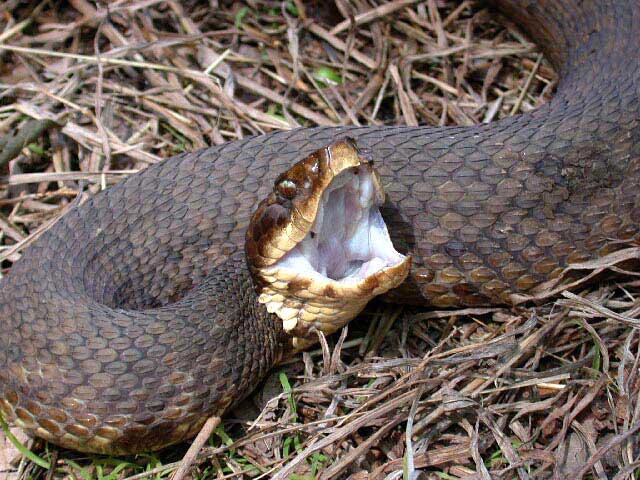RiskVA
Slithery Biters – Snakes 3 Aug 2004
East Texas has the dubious honor of being home to all four types of venomous snakes found in the United States. Rattlesnakes (pygmy and timber), copperheads, water moccasins, and coral snakes all prosper here.
Rattlesnakes, water moccasins and copperheads are pit vipers with sensors on each side of their head providing their owner a three-dimensional infrared picture of their prey, even in total darkness.
First Rule – Avoid ‘Em!
- Don't put your hands in places you can't see. Be careful taking wood off outdoor stacks. Knock a piece off with a stick first. Snakes love woodpiles.
- Watch where you're walking. Copperheads and rattlesnakes, in particular, have colors and patterns that camouflage them so well they become almost invisible. Also, be aware that rattlesnakes don't always rattle before they strike.
- Be especially careful around streams, ponds and lakes. Water moccasins there become very territorial and may not move as you approach.
- Be careful walking through tall grass and brush. Walk slowly to allow snakes time to escape.
- Wear proper clothing. A solid bite by a large rattlesnake can penetrate boots. Let your pant legs hang outside your boots so the snake can’t get a clear shot at you and may only tangle its fangs in the material of your trousers. (Scary, but not damaging.) Shorts and sandals are outdoor clothing fit only for totally inexperienced greenhorns.
Pit viper venom contains three potent enzymes: proteolytic, which destroys tissue such as muscles, hemolytic that destroys blood cells and sometimes, neurotoxic which attacks nerves, including those that control breathing and heartbeat.
In the United States, pit vipers usually have mostly proteolytic and hemolytic venom with only a very small amount of neurotoxic venom. However, the East Texas timber rattlesnake, Mojave rattlesnake and Southern California rattlesnake, have a significant amount neurotoxin in their venom. Because of this, their bites may not cause pain and a victim could assume, wrongly, that there is no problem. Bite victims of these snakes should be immediately rushed to a hospital.
Copperheads and water moccasins have venom that attacks body tissue and blood cells. Their bite causes immediate pain and swelling. Like rattlesnakes, they have large, hollow, retractable fangs in the front part of their upper jaw. In striking, they open their mouth nearly 180 degrees, extend their two hypodermic-needle-like fangs and slap them into the victim, usually, but not always, injecting a few drops of venom. About fifty percent of snakebites are “dry.” No venom is injected.
Coral snakes are not pit vipers and have venom that is mostly neurotoxic, causing little or no pain or swelling. Their bite is extremely dangerous because the venom attacks nerves that control breathing and heartbeat. However, because Coral snakes have very small mouths, it is difficult for them to bite anything large. They have short, fixed fangs requiring them to get a firm grip and chew to get through the skin. Venom runs down the surface of their fangs and is worked into the wound by the chewing action. Most coral snake bites occur when children, attracted by their bright red, yellow and black bands, pick them up.
Snakebite Treatment
- Apply a constricting band above the bite. An Ace bandage will work well. However, this does NOT mean a tourniquet. It is only intended to restrict lymph and capillary flow, never major vessels.
- If the bite is no more than ten minutes old, apply suction, preferably with a high vacuum device such as the Sawyer Extractor which is available at many outdoor and chain stores including Wal-Mart. NEVER, NEVER CUT THE SKIN! That is extremely dangerous and might actually speed venom absorption. Place a COOL, moist cloth on the bite site. Do NOT use ice. It can cause serious tissue damage.
- Splint the limb to immobilize it. Muscle action moves the venom through the body more rapidly.
- Transport the victim to an emergency room on a stretcher. Walking speeds venom spread. If you are alone and must walk, do it slowly. Medical personnel at the hospital may or may not use antivenin, injected intravenously, depending on the severity of the bite.
- Keep the victim calm. Reassure them.
Above all, remember there are no snakes (anywhere in the world) that are so poisonous that their bite cannot be successfully treated if medical aid is reasonably close. The so called “3-step snake” with a bite so deadly that three steps later the victim is dead, is a common misconception.
Dr. Risk is a professor emeritus in the College of Forestry and Agriculture at Stephen F. Austin State University in Nacogdoches, Texas. Content © Paul H. Risk, Ph.D. All rights reserved, except where otherwise noted. Click paulrisk2@gmail.com to send questions, comments, or request permission for use.


